
Sailcloth-style tents are synonymous with weddings—a trend that shows no signs of abating—and their appeal is spreading as event professionals become entranced by their beauty and light.
Sailcloth-style tents are strongly associated with rustic decor, a trend that has dominated the wedding scene for several years, accelerating demand for this tent design and prompting many rental companies to add these tents to their inventories. But is this wedding theme in danger of jilting its suitors? And if so, will these tents end up unwanted, languishing on the shelves?
Fred Tracy, president of Fred’s Tents and Canopies Inc., isn’t concerned about either outcome. Located in Waterford, N.Y., Fred’s manufactures The Stillwater sailcloth-style tent in addition to other tent styles.
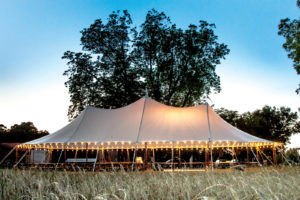
Initially, the sailcloth tent was a regional favorite in the New England/Cape Cod area, he says. But its popularity has spread across the United States and even to other countries, offering new rental opportunities as people fall under its spell. As far as the rustic and vintage-themed wedding trends go, Tracy believes the end isn’t nearly in sight.
“I don’t think we’re necessarily at the top of the bell curve just yet,” he says. “These types of weddings are still gaining momentum. We’re still seeing a big demand.”
Jeff Ginty, president of Durkin’s Inc., a full-service rental company in Danbury, Conn., is experiencing the same. Ginty purchased two Tidewater sailcloth tents manufactured by Aztec Tents in 2014 after noticing increased demand for this tent style in his area and doing some research.
“We analyzed our rental division, which accounts for 25 percent of our annual revenue, to decide which direction was most favorable,” he says. “We determined the wedding industry turned the largest profit margins.”
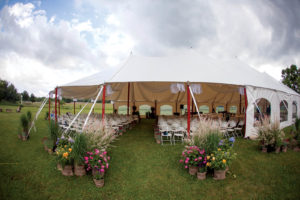
Offering sailcloth tents allowed Durkin’s to form relationships with wedding planners, multiple wedding venues and other industry professionals and has largely contributed to the 20 percent growth rate the company has experienced over the last few years. Now with four sailcloth tents in inventory, Ginty has only one regret:
“I wish we had invested in these sooner.”
Courting the markets
For many tent rental companies serving the wedding market, sailcloth-style tents have become a competitive necessity, says Jenny Cole, operations manager for manufacturer Charnecke Tents Inc. of Rosholt, Wis., which also operates a rental side.
The company began manufacturing its Bayview sailcloth tents in 2013, fueled by a desire to meet rental business demand for this tent style, says Cole. “We want to be a one-stop shop so any rental company can purchase any style of tent to meet their needs,” she says.
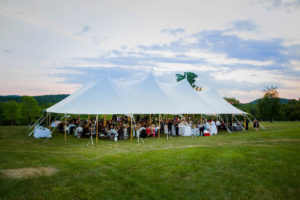
by Durkin’s, Danbury, Conn., for a wedding.
Photo courtesy of Durkin’s and Aztec Tents.
Brides were another factor; they see these tents in bridal magazines and on Pinterest and other social media and want them, says Cole. “If we didn’t have them, they’d go somewhere else,” she says. “And, once they rent the tent, we add on everything else that goes with the wedding.”
Brides do love the looks of these tents, says Daryl Sensenig, sales manager for Tents for Rent, a Lititz, Pa., rental business. Last year the company—which rents mainly pole tents—added an Aurora tent by Anchor Industries Inc. to its inventory.
“Weddings are the biggest event type we serve, but we have a very diverse clientele,” Sensenig says. “There’s quite a bit of interest in this tent. And even if brides don’t end up renting it, it’s an excellent way to differentiate ourselves from the competition and attract interest.”
But demand isn’t limited to weddings. Alex Kouzmanoff, vice president of Aztec Tents of Torrance, Calif., says these tents are popping up at food and wine festivals, anniversary parties and music festivals.
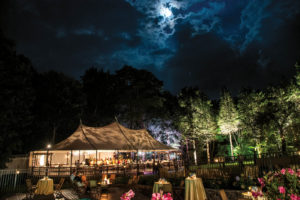
“The essence of this style of tent isn’t about being rustic, but rather how the light becomes a natural element in the event space,” he says. “The essence of light will certainly outlast any decor trends underneath the tent.”
It is all about the lighting, says Brian Richardson, president of L & A Tent Rentals in Hamilton, N.J., which boasts 15 Tidewater and Stillwater tents in its inventory.
“Thanks to their translucence, sailcloth tents create a magical glow for nighttime events,” Richardson says. “We’ve not seen any decline from this type of tent for weddings, and we’ve actually seen an increase of requests from some of our corporate and nonprofit clients who want something different for their event.”
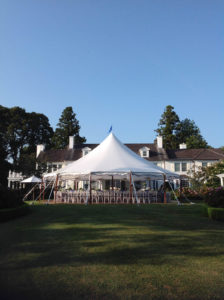
This tent style is effective when the objective is to attract attention, such as for grand openings, new product introductions and at car dealerships, says John Fuchs, general manager-special events for Anchor Industries of Evansville, Ind. The “beacon of light” effect these tents produce—thanks to their translucence and sheer tops—can really enhance an event, he says.
Corporate events are another rental opportunity, Tracy says. “Several of our clients have used them for these events and love that this tent has the ability to light a logo on the top of the tent,” he says.
Look before leaping
These tents are tempting, but there are some considerations to explore before bringing them on board. For example, even though these tents are serving other applications, the wedding industry is still where the demand is strongest, which can pressure tent rental companies that are less than full-service.
“Renters in this arena have a tendency to want to go to a one-stop shop,” Fuchs says. “Are [rental businesses] set up to provide a lot of what the brides are seeking? If not, do they have companies such as caterers and decorators to assist them?”
Rental companies should also calculate how many times per season they could rent a sailcloth-style tent, Fuchs adds. If only for an occasion or two, it might be smarter to sub-rent while building up demand.
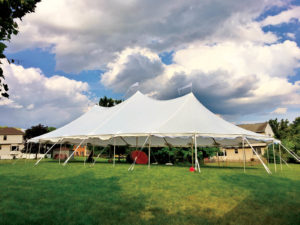
They’re also not right for every event. “Large conferences holding thousands of people, events requiring large amounts of overhead rigging, and situations that might require hard or glass walls are probably better suited for a frame-supported clearspan structure,” Kouzmanoff says.
Weather poses another constraint. Richardson doesn’t recommend them for late fall or early winter in the Mid-Atlantic region because keeping the heat in can be extremely challenging. And Cole points out that these tents will heat up during the hot summer months because their translucence lets so much light through. Air conditioning could help, but keeping cold air in would also prove difficult.
The rounded ends can present issues for installation crews, Fuchs says. Additional training may be required, and the first several installs may take longer (adding to labor costs) until the crew gets the hang of it.

You’ll also lose space inside these tents because of their rounded edges, says Richardson, who advises going a third larger with a sailcloth-style tent as opposed to a conventional one. They’re also harder to floor since the flooring also must be rounded and this has to be fabricated on-site, he says.
Highly translucent vinyl will show any patches or repairs, making it imperative to treat these tents carefully, Fuchs says. “Drop-cloths should be used on every installation,” he says. “Also, the install site should be closely inspected to identify any items that could puncture the tent, including overhead obstructions.”
As for their care and cleaning, Richardson says at L & A, the tents are opened up immediately upon their return and hung, even if they appear dry, because any moisture can cause them to mildew almost immediately. Dirty tents are hand rather than machine-washed. (If you do put the fabric through a tent washing machine, Fuchs advises wrapping metal plates and fittings to minimize the chance for abrasions or punctures.)
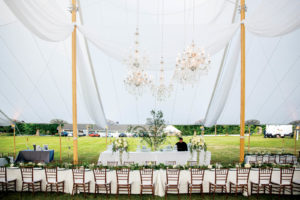
a wedding with 240 guests in the rolling hills of Litchfield County, Conn. Planning and design: Amy Champagne Events. Photo by Roey Yohai Photography.
Storage is the same as for any other tent, although they especially should be kept off of concrete floors, Cole says, explaining that even if the floor seems dry, over time these tents will wick the moisture from the floor. Storing them on a pallet is a better option, she says.
But perhaps the most important factor to consider was the one motivating Ginty. “Honestly, we were looking for ways to improve our bottom line,” he says. “I knew the sailcloth tent was a definite answer. Anyone can buy one, but paired with a proper marketing strategy, the results are history.”
Pamela Mills-Senn is a Long Beach, Calif.-based freelance writer.
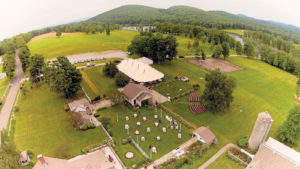
Sailcloth tents won’t just sell themselves sitting on a shelf, says Alex Kouzmanoff, vice president of Aztec Tents.
“We’ve found our most successful clients have hosted their own private events to introduce the product to party planners, caterers and other event professionals,” he says. “The best sales tool is having a prospective client attend an event under a sailcloth tent.”
Jeff Ginty, president of Durkin’s, says letting customers know you have them is the first step in putting the tents to work.
“Start with building a portfolio of professional pictures by asking the manufacturer to supply you with high-resolution images to share on your website and through social media,” he says. “Facebook, Instagram and Pinterest are great applications.”
Augment and customize this portfolio by hiring a professional photographer to capture images of your own installations, sharing these on social media as well. “A picture paints a thousand words and helps people envision their own event,” he says.
 TEXTILES.ORG
TEXTILES.ORG


